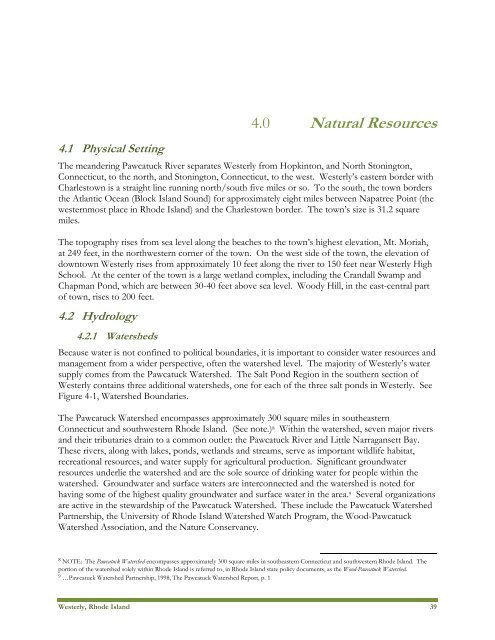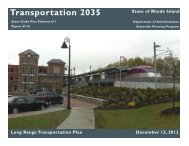Westerly - State of Rhode Island: Division of Planning
Westerly - State of Rhode Island: Division of Planning
Westerly - State of Rhode Island: Division of Planning
Create successful ePaper yourself
Turn your PDF publications into a flip-book with our unique Google optimized e-Paper software.
4.1 Physical Setting4.0 Natural ResourcesThe meandering Pawcatuck River separates <strong>Westerly</strong> from Hopkinton, and North Stonington,Connecticut, to the north, and Stonington, Connecticut, to the west. <strong>Westerly</strong>’s eastern border withCharlestown is a straight line running north/south five miles or so. To the south, the town bordersthe Atlantic Ocean (Block <strong>Island</strong> Sound) for approximately eight miles between Napatree Point (thewesternmost place in <strong>Rhode</strong> <strong>Island</strong>) and the Charlestown border. The town’s size is 31.2 squaremiles.The topography rises from sea level along the beaches to the town’s highest elevation, Mt. Moriah,at 249 feet, in the northwestern corner <strong>of</strong> the town. On the west side <strong>of</strong> the town, the elevation <strong>of</strong>downtown <strong>Westerly</strong> rises from approximately 10 feet along the river to 150 feet near <strong>Westerly</strong> HighSchool. At the center <strong>of</strong> the town is a large wetland complex, including the Crandall Swamp andChapman Pond, which are between 30-40 feet above sea level. Woody Hill, in the east-central part<strong>of</strong> town, rises to 200 feet.4.2 Hydrology4.2.1 WatershedsBecause water is not confined to political boundaries, it is important to consider water resources andmanagement from a wider perspective, <strong>of</strong>ten the watershed level. The majority <strong>of</strong> <strong>Westerly</strong>’s watersupply comes from the Pawcatuck Watershed. The Salt Pond Region in the southern section <strong>of</strong><strong>Westerly</strong> contains three additional watersheds, one for each <strong>of</strong> the three salt ponds in <strong>Westerly</strong>. SeeFigure 4-1, Watershed Boundaries.The Pawcatuck Watershed encompasses approximately 300 square miles in southeasternConnecticut and southwestern <strong>Rhode</strong> <strong>Island</strong>. (See note.) 8 Within the watershed, seven major riversand their tributaries drain to a common outlet: the Pawcatuck River and Little Narragansett Bay.These rivers, along with lakes, ponds, wetlands and streams, serve as important wildlife habitat,recreational resources, and water supply for agricultural production. Significant groundwaterresources underlie the watershed and are the sole source <strong>of</strong> drinking water for people within thewatershed. Groundwater and surface waters are interconnected and the watershed is noted forhaving some <strong>of</strong> the highest quality groundwater and surface water in the area. 9 Several organizationsare active in the stewardship <strong>of</strong> the Pawcatuck Watershed. These include the Pawcatuck WatershedPartnership, the University <strong>of</strong> <strong>Rhode</strong> <strong>Island</strong> Watershed Watch Program, the Wood-PawcatuckWatershed Association, and the Nature Conservancy.8 NOTE: The Pawcatuck Watershed encompasses approximately 300 square miles in southeastern Connecticut and southwestern <strong>Rhode</strong> <strong>Island</strong>. Theportion <strong>of</strong> the watershed solely within <strong>Rhode</strong> <strong>Island</strong> is referred to, in <strong>Rhode</strong> <strong>Island</strong> state policy documents, as the Wood-Pawcatuck Watershed.9 …Pawcatuck Watershed Partnership, 1998, The Pawcatuck Watershed Report, p. 1<strong>Westerly</strong>, <strong>Rhode</strong> <strong>Island</strong> 39
















